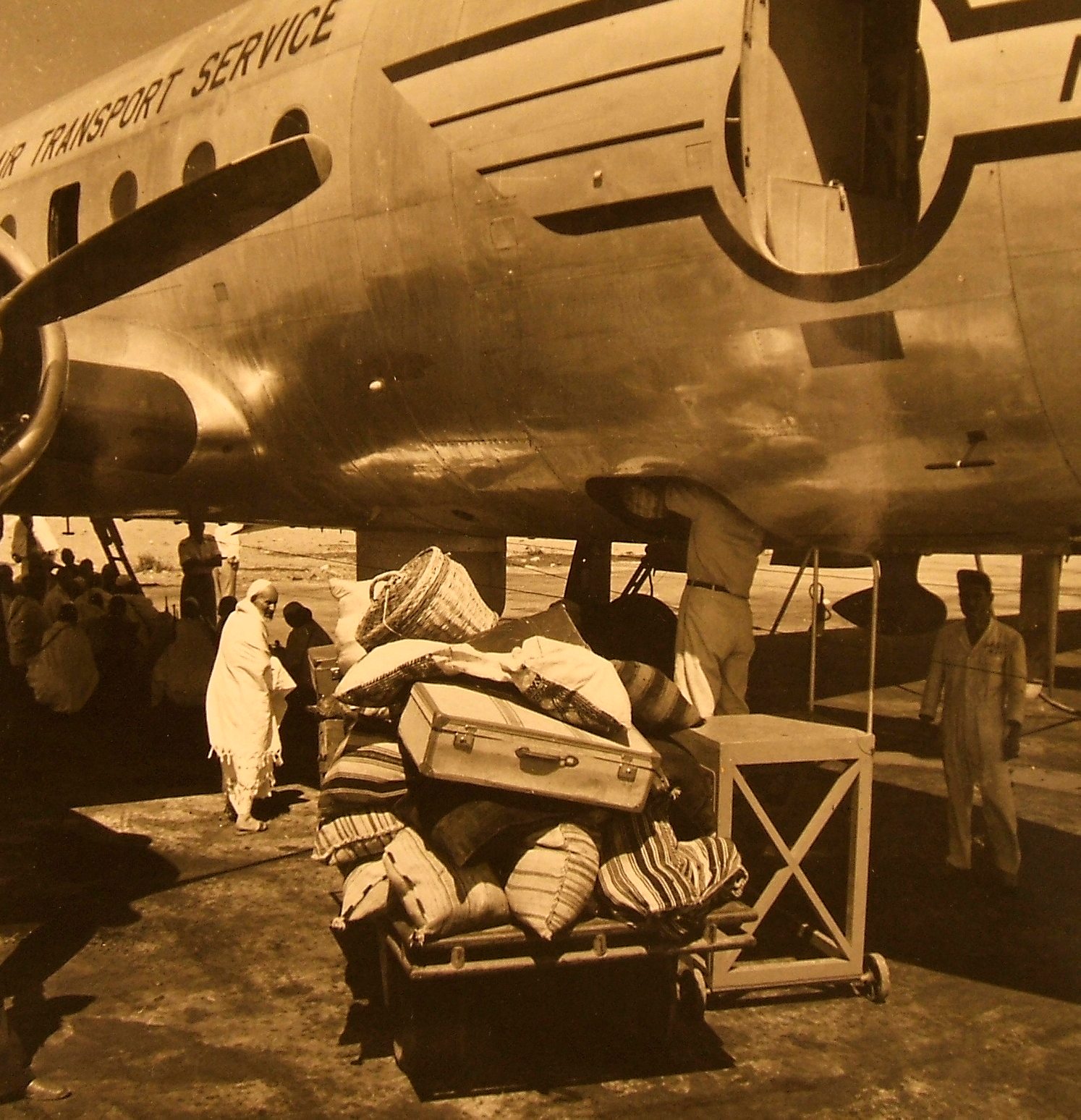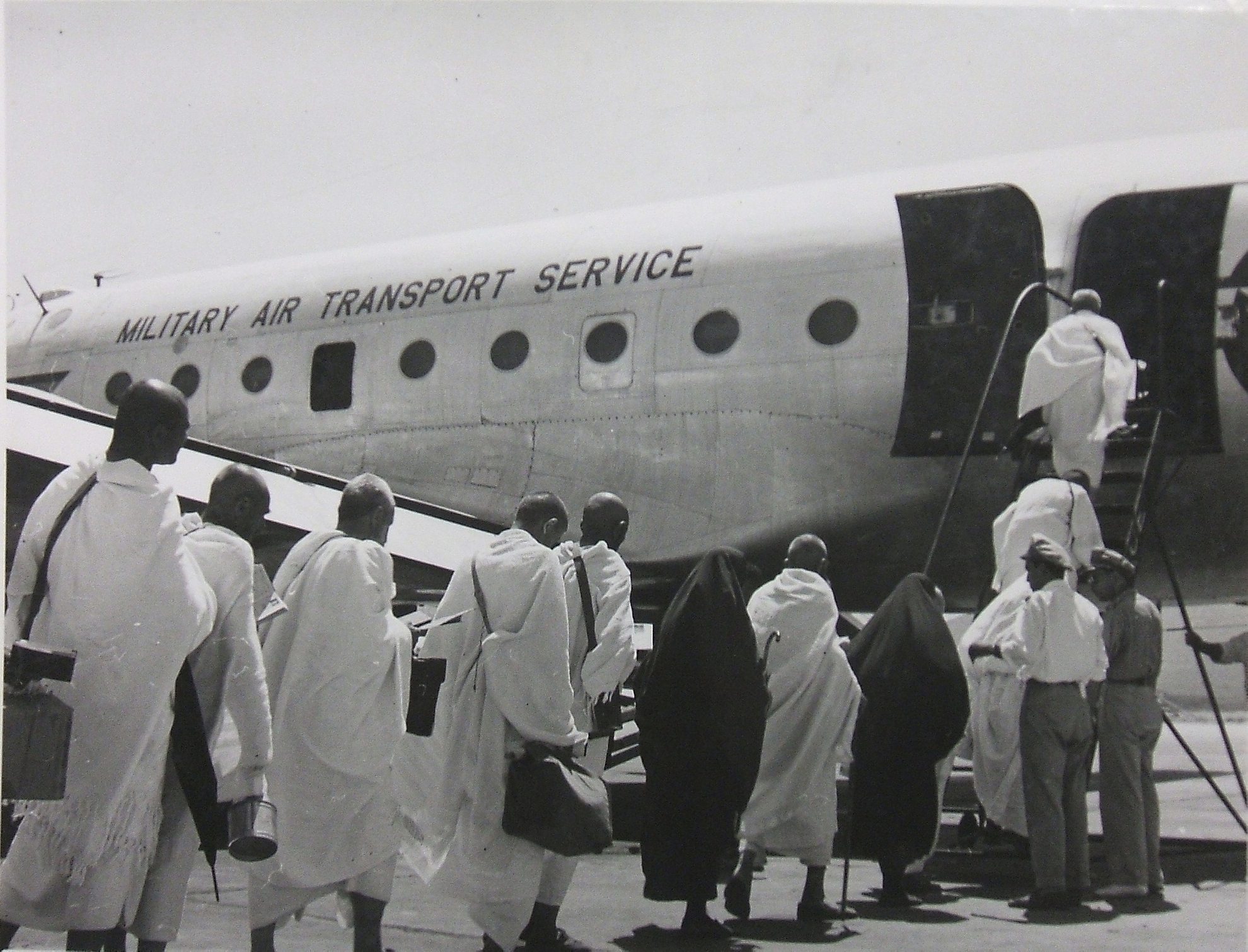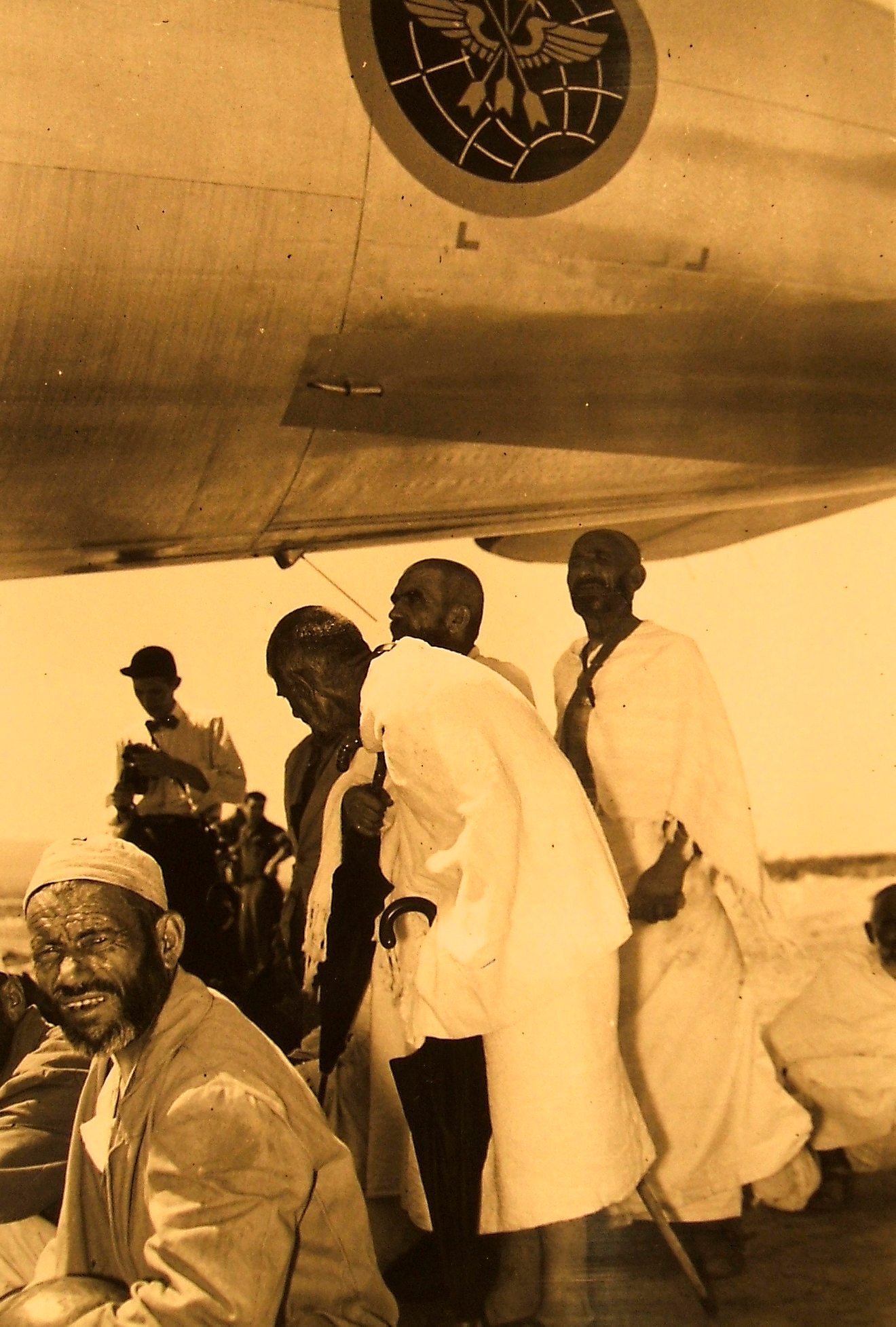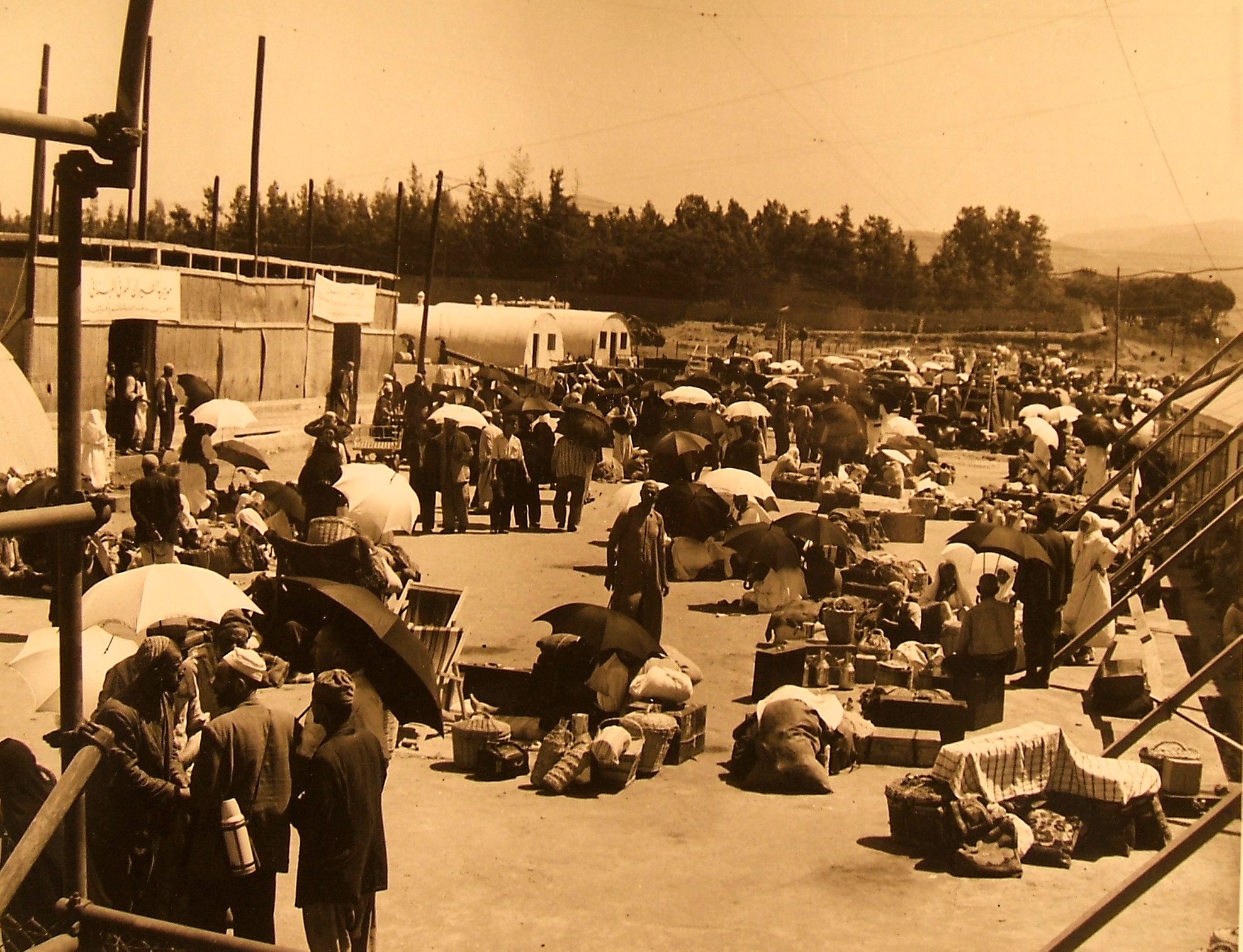In advance of this year’s hajj, a look back to 1952 and the unusual airlift that brought pilgrims to Saudi Arabia in U.S. military transport planes.
In 1952 an unidentified young photographer—wearing a bow-tie, looking at his camera, presumably at work for the US government—stands by a C-54 transport plane on a Beirut tarmac. In front of him, Muslim pilgrims in white robes prepare to board the plane en route to Mecca. Another photographer for the United States Information Service captures the whole scene, complete with the US Air Force logo on the plane’s fuselage.
It was an American PR dream, a propaganda coup so good that the government photographs carefully documenting it were deemed superfluous and have seldom if ever been seen. Shortly after arranging for several thousand stranded pilgrims to be airlifted from Beirut to Saudi Arabia, the State Department cabled its Middle Eastern embassies telling them best not to go overboard trumpeting the story. Local press would do the work for them, and with too much boasting the embassy risked promoting the story to the point they “killed it with self praise.”
Fortunately the New York Times faced no such limitations: “Mecca Pilgrims Ride U.S. Magic Carpet” it declared. “The United States Air Force spread its magic carpet today to help fly 9,000 stranded Moslem pilgrims to the holy cities of Mecca and Medina. Thirteen four-engined C-54 transports began the religious airlift from Beirut to Jidda, [the] Saudi Arabian seaport only forty miles from Mecca, where the prophet Mohammed is entombed.”

Before the annual 1952 pilgrimage to Mecca, the Saudi government cut a once hefty tax on pilgrims, dramatically increasing the number who could go on the Hajj. As a result, an unprecedented number of the faithful and hopeful had come to Beirut with tickets to continue on aboard Middle East Airways. But the Lebanese carrier could not cope with the unexpected number of travellers, and stranded pilgrims from around the Muslim world began camping out across the city. When a Lebanese parliamentarian contacted the U.S. State Department about providing assistance, Washington quickly saw an opportunity for modern American magic to save the day.
Journalists, too, embraced an opportunity to run wild with the tradition-meets-modernity cliché that was already in the early 50s becoming de rigeur for U.S. reporting on the Middle East.
Though the operation was officially named Operation Hajji Baba—after a famous 19th century British orientalist novel about Hajji Baba of Ispahan—reporters upped the cliché by redubbing it “Magic Carpet.” The Times wrote that the stranded pilgrims, in their “colorful native dress… cook on little portable oil stoves, smoke their oriental pipes, count their prayer beads, read the Koran, and at the prayer hours prostrate themselves in the direction of Mecca.”

Set against this imagery was a modernist fascination with the enumeration of American technology. If the Times had been a bit imprecise in locating Mohammad’s tomb (it’s in Medina), the paper reveled in the numerical precision of American logistics: 13 planes, 4 engines each, 9,000 pilgrims. Then, continuing on in the next paragraph, as if in a math problem: 50 pilgrims per plane, one plane per hour…
In short, the American technological might and military organization that carried the day during the Berlin Airlift—not to mention the Second World War—had finally come to the Middle East. Any lingering Arab bitterness over from Washington’s decision to recognize of Israel would soon be swept away by a wave of American know-how, goodwill and can-do spirit. That was the idea, at least.
When the operation ended not all the pilgrims had made it to Mecca, but at least 3,783 of them had, and for Americans involved the success seemed complete. The Mufti of Lebanon ordered “prayers for Americans,” and the King of Saudi Arabia gave $6,000 dollars worth of “flowing Arabian costumes” to the mission’s pilots. One Beirut paper supposedly wrote that while the U.S. might have given Israel material aid, it had given the Arabs spiritual aid, a “far greater gift.” In Ankara, a US diplomat suggested that his boss save the dry carbon-copied memo reporting the operation’s conclusion as a keepsake. The Times again waxed poetic: “The airlift ends today, but the good it did will live on. Though some may carp at the cost to the United States taxpayer… we do not doubt that this is a gesture that will be repaid many times over. More than 3,000 Moslems… will have a true story to tell which should do much to counteract the Soviet’s anti-American propaganda. They will tell their people the story of the Magic Carpet and tell them that the Magic Carpet bore the label Made in U.S.A.”

“So is that supposed to make up for the U.S. helping the Jews to steal Palestine and Masjid al Aqsa?” Stumbling across a 2011 account of Hajji Baba online, one Aussie Muslim responded with exactly the cynicism we might expect today. “It’s clear,” added another, that the U.S. acted for its own benefit, “not to help the Muslims.”
Incidentally “the Jews” might also have good reason to be more cynical about this story today too. The feel-good version dodges the always-sensitive issue of U.S. relations with the Saudi monarchy, more precisely the fact that, according to one U.S. participant, the Air Force quietly complied with the Saudi government’s request that no Jewish pilots be allowed to participate.
Yet when I came across this story, along with the accompanying photos, in the U.S. National Archive last spring, it struck me as both contemporary and anachronistic in a way that created an uncomfortable historian’s version of 50s nostalgia. Certainly today many people continue to hope that the U.S. military’s logistical capabilities can serve to demonstrate American goodwill abroad. The Air Force has published several laudatory accounts of its involvement in Hajji Baba, and others have made the comparison with more recent operations like the U.S. Navy’s 2004 tsunami relief in Aceh and elsewhere. But the hopes surrounding Hajji Baba are also clearly the product of an earlier era. One where we as Americans had more of an excuse for our ignorance; when we thought ruling the world was going to be easy and had faith in the propaganda value of good deeds. An era, in short, when our arrogance was tainted by excessive earnestness instead of cynicism.

Despite the sincere praise Hajji Baba earned in the Arab press, no one forgot about Israel. In the long run, it was the very optimism with which American policymakers expected a few good deeds to paper over profound political differences that led many Middle Easterners to develop their own cynicism about the disparity between American words and deeds.
Over the past half century Americans have gained a much more detailed understanding of the Islamic faith, but its often done less to promote good will than the uninformed exuberance of an earlier time. In addition to being confused about the Mohammad’s burial place, the New York Times also claimed that, at the end of the Hajj, Muslim pilgrims sacrifice animals to commemorate “Abraham’s attempt to sacrifice his son Isaac to the Lord.” Now most Muslims might say that Abraham was trying to sacrifice his son Ishmael, and they might say “Allah” instead of “the Lord.” The reporter was certainly not alone in being unaware of the obscure historical and theological factors that led the Quran to replace one brother with the other in its version of Abraham’s tale. But he gave Islam what in in his own Christian confidence was most likely the benefit of the doubt. And he did it again with “the Lord.” An anonymous U.S. army author took the same approach in explaining to readers what this curious Islamic festival was all about: Muslims were celebrating “a religious feast which may be compared to the Jewish Passover, or possibly to our Thanksgiving.” Well, sort of. There’s plenty to eat.
The Hajji Baba airlift took place in an era when a Turkish journalist visiting North Carolina was asked to lecture local civic clubs about popular Christmas customs in Turkey. It was an era when State Department documents consistently classified the embassy’s propaganda activities, including this one, in folders marked “propaganda.” And it was also an era, apparently, when we thought Muslims would love us if only we gave them a lift so they could make it to their Thanksgiving on time.